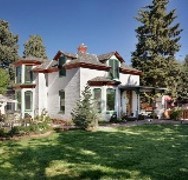85 N 8th St
Introduction
Text-to-speech Audio
85 North 8th Street has housed some of Carbondale's most influential residents. Philip E. Weaver is the first owner of record of these lots. It is not clear when he acquired the property, but they were a part of the large tract of land that he ranched, directly adjacent to the north side of the original townsite. This home was one of the first in the area, built in 1883. The Denver & Rio Grande railroad cut a swath diagonally across the Weaver property from the northwest to the edge of the townsite when it arrived in 1887. The arrival of the railroad may have motivated Mr. Weaver's shift from ranching to real estate development, as he began to sell off the lots between the railroad and the townin the late 1880's. Several well-known area residents bought into the Weaver Addition, including J.C. Osgood, the owner of Colorado Fuel & Iron. Philip Weaver died in 1889 at the age of 55, possibly due to his diabetic condition. In 1895 Millie Sonner purchased the property. At that time, this area of town was outside of the original townsite and may have included cultivated land that was associated with the house. Millie's husband Jacob was a manager at Dinkel's Mercantile. When Millie passed away in 1937, her estate sold the home to Albert & Martha Witchey. Albert served as Carbondale's mayor from 1938 to 1946. He was the manager of Dinkel's and later owned Witchey's Cash Store at 311 Main Street. A former teacher, Martha was the store's buyer for women's and children's clothing. The Witcheys lived in the home for 24 years and raised four children. After Albert's death in 1969, Martha became involved in a number of church and community projects, and was voted Carbondale's Woman of the Year in 1973. This architectural style is Late Victorian - the complex form and shape, the vertically proportioned double-hung windows in segmentally arched openings, and the porch with decorative detailing define features of the style. At one time there was a widow's walk on the upper roof. Other modifications made in the 1970's include changes to the dormers and bays, the southwest corner addition, and possible alterations to the porch and roof. This home has been owned by only four families and is quite significant in the development of Carbondale.
Images


Backstory and Context
Author-Uploaded Audio
Listen to a narration of this entry's description by Carbondale HPC.
Text-to-speech Audio
Late Victorian
Sources
Town of Carbondale 2010 Architectural Survey (Reid Architects, Inc.)
carbondalegov.org
Carbondale Historical Society
